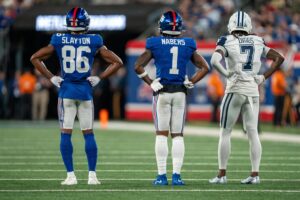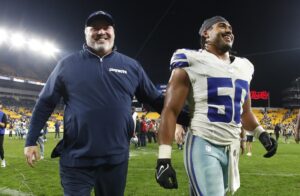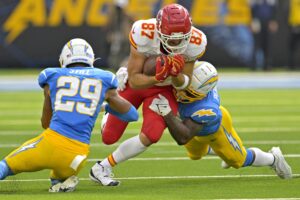The NFL Combine is an exciting event. Interviews, medical evaluations, on field testing and measurements all wrapped into one magical week. Time and time again we fall in love with prospects because they broke the record, set a new high or tested at insane numbers for their size. But the more important thing at time can be thresholds. We hear time and time again how wide receivers fall because they didn’t mean combine thresholds. After examining the last five draft classes, there seem to be lines in the sand drawn for each event, and if they don’t meet those thresholds, they fall to Day Two or even later. Draft capital is huge for dynasty fantasy football and for our favorite teams, so let’s dive into the numbers.
Key Measurements for Wide Receivers at the NFL Combine
40-Yard Dash
Bottom line up front, in the last five draft classes no wide receiver has run below a 4.6 and been drafted in the first round. For what it’s worth, the only receiver to run over a 4.6 and be drafted in the first round since 2014 is Kelvin Benjamin, so do with that information what you will. The speedsters don’t always work out but hitting that 4.6 threshold is critical to getting first round draft capital. Treylon Burks ran the slowest 40 of the last five draft classes at 4.55.
Receiver Likely to Dominate 40-Yard Dash
Vertical Jump
Receivers need to be explosive, plain and simple. The vertical and broad jumps are an easy way to measure it (outside of good old fashioned film studies). Chris Olave had the lowest vertical jump of first round wide receivers the last five drafts at 32 inches. The marker for first rounders is at the 30-inch mark, but Olave is one of the lowest of the last ten years.
Broad Jump
Look away Broncos fans. Jerry Jeudy had the lowest broad jump at 120 inches, but a lot of receivers drafted highly were in the 120-125 range. The line is a little more fluid here, but anything below 120 would be an outlier.
Three Cone
Jaxon Smith-Njigba turned some heads with his 6.57 second three cone last year. The short area quickness definitely pops of the field as well. On the flip side, Jalen Reagor’s 7.31 second three cone was a red flag for some folks. Josh Doctson, Jalen Reagor and Treylon Burks were the only three first round receivers to participate and post over a 7.2 second three cone. Seven seconds should be a concern, but 7.3 might be a firm line moving forward.
Short Shuttle
This isn’t meant to bully Jerry Jeudy. But he also had the worst short shuttle with 4.53 seconds. Reagor was the only other first round receiver to post over a 4.4. To secure first round capital, 4.55 is key, but higher than 4.3 should concern fans.
Film Study on Physical Freak in 2024 Class
Bench Press
This one truly doesn’t matter for receivers, but it’s fun to compare the numbers. Kadarius Toney posted nine reps on bench, while N’Keal Harry put up triple that at 27 reps. Again, this does not translate to football production in any way shape or form. But just an interesting anecdote, Ceedee Lamb and Brandon Aiyuk both did 11 bench reps and were the only two to put up that exact number. Coincidence? Surely.
Last Word on Combine Thresholds for Wide Receivers
It’s exciting to look at the fastest, strongest, highest jumping players. But the combine thresholds are more important. Those thresholds appear to be 4.6 for the 40, 30 for the vertical, 7.3 for the three cone and 4.3 for the short shuttle. If a receiver doesn’t hit these, this isn’t to say they won’t be good, just that they are unlikely to secure a first-round pick and the commitment from a team that comes with that.
Main Photo Credit: Ben Lonergan/The Register-Guard / USA TODAY NETWORK






